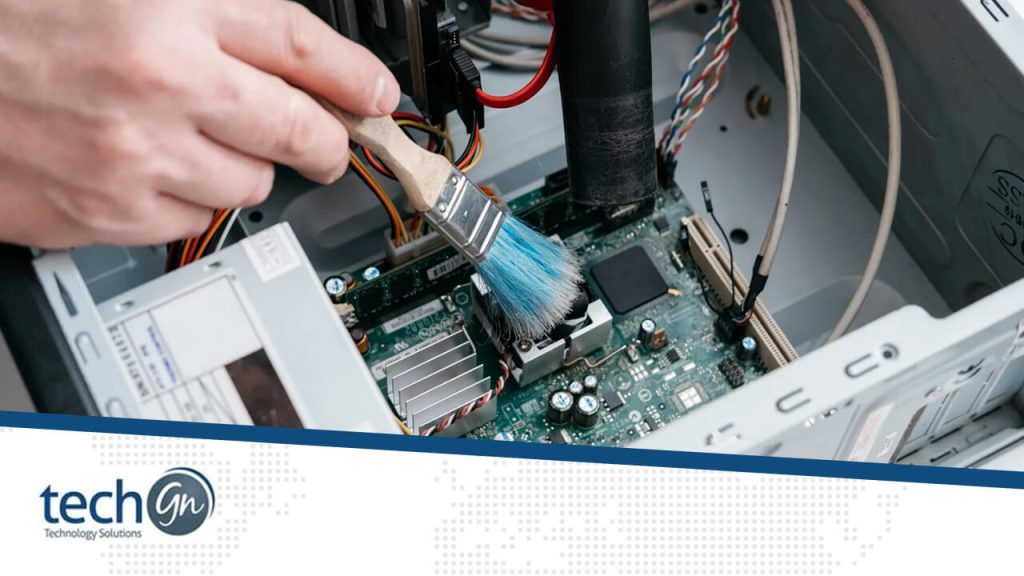The Dust Menace: Understanding the Problem
There are microscopic foes at work here, my buddy. There is more to those ostensibly harmless dust particles than first meets the eye. They are causing trouble rather than just settling down for a comfortable visit. Imagine your CPU cooler trying to dissipate heat while being protected by layers of dust. Due to clogged fans, a graphic card is panting for air to stay cool. Dust plays unfairly and dishonestly.Essential Tools for the Task
Half the fight is fought by equipping oneself with the appropriate tools. Your knights in shining armor for gently removing the invasive dust without damaging sensitive surfaces are soft microfiber cloths and brushes. However, there’s still more. The cavalry of your armory, compressed air canisters, blast even the most tenacious dust bunnies out of the tightest spaces. And what about those stubborn adhesive traces? Isopropyl alcohol makes the decisive move.Preparing for a Cleaning Session
Prior to starting your cleaning adventure, put safety first. That setup should be turned off and disconnected from its power supply. A little proactiveness goes a long way in preventing unintentional short circuits, aside from safety. Once it is finished, open the cases and remove any other parts, like as RAM and graphics cards. We’re making room so we can do a thorough cleaning.Delicate Dance: Cleaning the Components
The creative element enters at this point. Your motherboard has to be handled gently due to its complex circuitry. The ideal dancing partner for this is a soft brush or a microfiber cloth. Fans and heat sinks now demand some attention as well; they are the workhorses. Forget about cleaning, though; a little blast of compressed air drives those dust devils away. Don’t allow your monitor and other accessories feel left out, either. They deserve a wipe-down for that squeaky-clean finish.Mastering the Art of Cable Management
The unsung heroes of your system are your cables. But hold on, tangled connections are a dust party open invitation. Enter cable management, which not only enhances ventilation but also stops dust from hiding in crevices. If you manage those wires with sleeves and clips, your system will be cleaner, more organized, and more aesthetically beautiful.The Right Frequency: Setting a Cleaning Schedule
The age-old conundrum of cleaning frequency. Your surroundings and use patterns are among the variables. a broad guideline? A quarterly cleaning for settings in less dusty areas, and potentially a monthly cleaning for metropolitan settings. Find your groove, but never completely ignore the cleaning dance.Environmental Factors: Reducing Dust Intrusion
Have you ever thought that the air quality in your room may be the cause of the constant inflow of dust? By capturing airborne particles before they settle, an air filtration system may act as your protection. Strike a balance with the humidity as well; if it’s too dry, mold can grow; if it’s too humid, dust can become airborne. Keep everything in balance to create a setting and surroundings that are healthy.The Long-Term Gains: Benefits of a Dust-Free Setup
It’s not only about looks; it’s also about lifespan and durability. greater thermal efficiency, greater performance, and the prevention of component throttling owing to excessive heat are all benefits of a dust-free setup. Additionally, you’ll benefit from extended PC component lifespans, which will reduce the need for pricey replacements. Not to mention the visual attraction; having a setup free of dust gives one a sense of pleasure.
Cleaning up after your PC is more than just a bother in a world where dust is everywhere. It’s your duty. Remember that a dust-free setup is about a smoother, more effective digital experience as you begin out on your adventure with microfiber cloths, compressed air, and a newfound appreciation for cable management. You, my friend, deserve the best performance that your PC can provide, and your PC deserves the care.
Reviews


